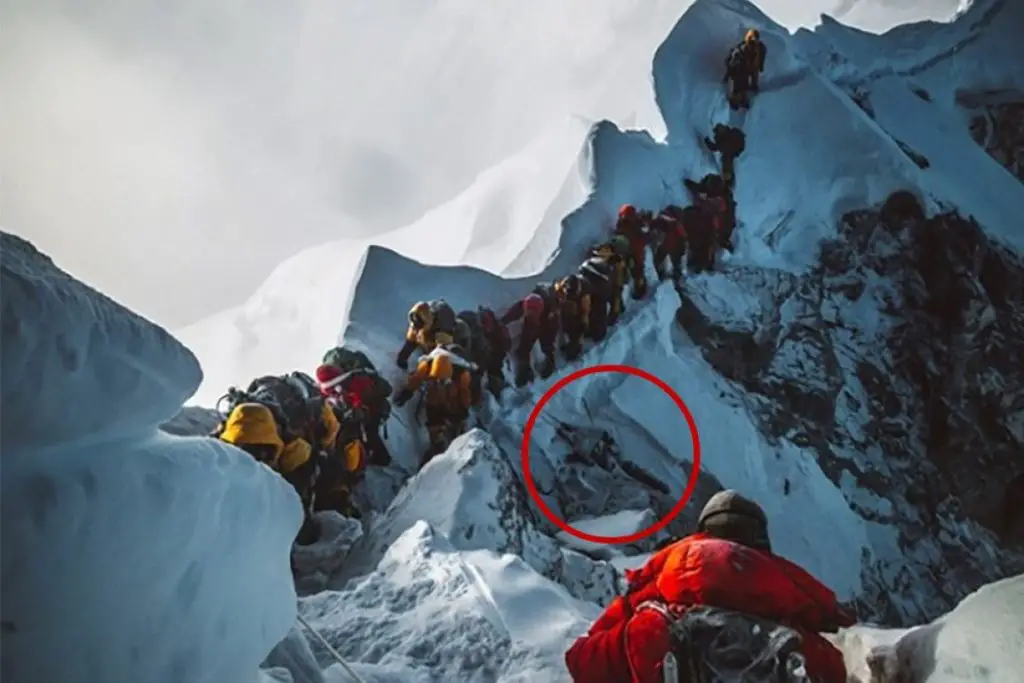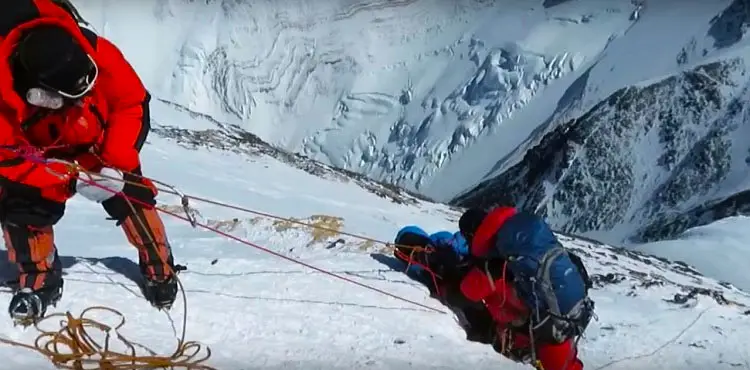Mount Everest, the tallest mountain in the world, is a popular destination for adventure seekers and mountaineers. However, climbing the mountain is a dangerous and challenging endeavor that requires skill, strength, and perseverance. One of the most dangerous areas of the mountain is Rainbow Valley, located in the death zone of Mount Everest.
In this blog post, I discuss the story around the Rainbow Valley section of Mount Everest, as well as its history and tragic stories associated with Rainbow Valley on Everest. You can also check out my other blog if you are curious about why so many people keep dying on Everest!
Quick Facts On Rainbow Valley on Everest
- In 1953, Tenzing Norgay and Edmund Hillary accomplished the inaugural confirmed ascent of Mt. Everest. Since then, the mountain has tragically claimed the lives of over 300 climbers, with the majority of these fatalities occurring within the Death Zone.
- At extreme elevations, reduced air pressure means an individual can only inhale about 30% of the oxygen they would normally get at sea level.
- Without proper acclimatization, a person accustomed to sea-level conditions would lose consciousness within two to three minutes while in the Everest Death Zone.
- The harsh conditions within the Death Zone extend the ascent from South Col to Everest’s summit to a grueling 1.72km trek, often taking up to 12 hours for climbers.
- “Mortality on Mount Everest” study reveals that early factors linked to subsequent fatalities include severe fatigue and delayed summit times due to the extreme conditions.
- Retinal haemorrhages can affect one in four climbers on Everest, and while they often improve upon descending to lower altitudes, they can still prove fatal within the Death Zone.
Where is the Rainbow Valley on Mount Everest?

The mountain’s darker side is unveiled in the less-known aspect of Everest, often dubbed the “Rainbow Valley.” Despite the picturesque imagery the name might conjure, the reality starkly contrasts. This region serves as a haunting graveyard for climbers who have met a tragic fate. The bodies scatter below the northern ridge of Mount Everest at an altitude exceeding 8,000 meters, serving as a chilling reminder of the mountain’s perils.
These corpses, adorned in vibrant blue, red, orange, and green jackets, lend the area its colorful moniker. Multicolored debris, including tents, cans, and oxygen tanks, also contribute to the rainbow-like appearance that characterizes this grim site.
How Did Rainbow Valley Everest Get Its Name?

The name “Rainbow Valley” on Everest originated from the numerous brightly colored jackets and gear of deceased climbers. One can easily spot them scattered across the snow-covered slopes. These colors create a beautiful rainbow-like effect that is both haunting and surreal.
It is unknown who coined the term Rainbow Valley, but it grew in popularity from 1990-2010 as the number of people dying on Everest increased. The area in the death zone is a stark reminder of the dangers and risks involved in attempting to summit the world’s highest peak and a sad tribute to those who have lost their lives in pursuit of this ultimate mountaineering challenge.
Since 1922, the Death Zone has taken the lives of over 300 climbers. The year 2015 marked a grim milestone, with an avalanche claiming the lives of at least 19 climbers, making it the deadliest year for Everest. With casualties still on the rise, Rainbow Valley bears witness to an ever-growing display of vibrant hues.
Why are Dead Bodies Piling Up in the Rainbow Valley Everest?
The path to the summit in the death zone is extremely narrow and can only accommodate one person at a time. Consequently, the bodies of climbers who perish along this treacherous stretch are pushed down to the area below, ending up in Rainbow Valley. As a result, anyone who loses their life in the death zone will find their final resting place in the world’s largest open-air cemetery.
Climbing in Rainbow Valley and the death zone of Mount Everest is a dangerous activity that involves a high risk of injury or death. The hazards associated with climbing in the area include altitude sickness, frostbite, hypothermia, avalanches, and falls. As a result, many climbers have died on Mount Everest over the years, and their bodies have been left behind, often in Rainbow Valley.
Due to the extreme altitude and difficult terrain, it is nearly impossible to recover all the bodies. Therefore, they remain on the mountain, creating a macabre landscape that serves as a grim reminder of the dangers of climbing.
What Happens To The People Who Die in the Rainbow Valley?
The majority of these fatalities transpire within Everest’s “death zone,” an area situated above 8,000 meters. The hostile environment, defined by thin air, severe weather, and fierce winds, incessantly challenges survival. The narrow trails within the death zone allow little space for the fallen, often pushing the bodies aside, finding their ultimate resting place in the Rainbow Valley.
Due to the extreme altitude and difficult terrain of Rainbow Valley, recovering dead bodies is a dangerous and costly operation that is often unsuccessful. As a result, many bodies left behind on the mountain have become landmarks for climbers, serving as a grim reminder of the dangers of climbing.
The price for retrieving a body exceeds USD 70,000. Despite the payment of this sum, the retrieval process remains arduous and may lead to additional fatalities. In 1984, two Nepalese mountaineers perished while attempting to recover a body from the death zone. The recovery of a body cannot be assured, even with ample funds. Retrieval teams are unwilling to undertake the task, resulting in the accumulation of corpses in Rainbow Valley.
Popular and Famous Stories about Rainbow Valley Everest

With a rich climbing history, Everest is not short of famous stories about climbers from yesteryear. While the climb can take months, climbers tend to share renowned tales about the mountain and some of the famous dead bodies on Everest and remaining in Rainbow Valley. The most well-known of these stories include Green Boots, Sleeping Beauty, and Hannelore Schmatz.
1. Green Boots
The unidentified body (unofficially) of a climber touting green boots became a landmark on the primary Northeast ridge route of Mount Everest. The moniker derives from the bright green mountaineering boots adorning the deceased climber’s body, visible to subsequent climbers.
Green Boots met his tragic fate during the ill-fated 1996 Everest expedition. The location of the body, in a high-traffic area near the summit, makes it a chilling reminder of the mountain’s perilous nature. Climbers on their way to the summit often pass by this haunting sight, a somber reminder to the risks and challenges they face in their ascent.
2. Sleeping Beauty – Francys Arsentiev
Francys Arsentiev, or the Sleeping Beauty was the first American woman to summit Mt. Everest without supplemental oxygen on May 22, 1998. However, after Francys and her husband’s successful summit ascent, she became uneasy while descending. A rescue team arrived after three days to find her stranded on the peak without supplementary oxygen.
When the team located her, she was barely breathing, severely frostbitten, and near death. The team tried to rope her down the mountain as far as possible, but it proved too challenging to bring her down further. As a result, they left her to pass away in the shadow of Mt. Everest. They discovered her lying on her back, resembling a peaceful sleeper, and subsequently nicknamed her “Sleeping Beauty.”
3. Hannelore Schmatz – German mountaineer
Hannelore Schmatz, a German mountaineer, was the first woman to die on the slopes of Mount Everest. In 1979, she and her husband joined a group of six climbers and five sherpas to ascend the mountain. The team successfully reached the summit. However, during the descent, Hannelore and American climber Ray Genet grew too exhausted to make it back. They decided to spend the night with a sherpa in the death zone.
A snowstorm hit and Ray Genet died of hypothermia. Hannelore and the sherpa survived, but she later fell and never got back up, dying at 8290m. Her body remained on the mountain for years and became the subject of a tragic story after two climbers died while attempting to recover it. Eventually, her body was swept away by strong winds.
4. Scott Fischer
Scott Fischer was an experienced mountaineer who had previously climbed Everest multiple times. However, during his fatal climb in 1996, he suffered from the effects of high altitude and exhaustion. Despite the efforts of his teammates, who attempted to locate and save him, Scott ultimately succumbed to his physical and environmental challenges. He tragically lost his life on the mountain he had come to know so well.
His death, along with several others on that fateful day, has continued to serve as a reminder of the unforgiving nature of Everest and the importance of careful planning, preparation, and decision-making when climbing at such high altitudes.
The story of Fischer was well documented in the movie “Everest”. If you want to see more great movies like that, make sure to check out my blog covering the best movies about Everest!
Key Takeaways: Rainbow Valley on Everest
Mount Everest stands as the ultimate aspiration for numerous climbers worldwide, despite presenting various challenges and risks. The unparalleled sense of accomplishment achieved by standing at Earth’s highest point motivates individuals to brave these dangers.
With a death ratio of under 1% and thousands of successful summits, Mount Everest remains an alluring destination for adventurers globally. Two primary routes lead to the summit: the southern route from Nepal and the northern route from Tibet. The southern route, famously taken by Tenzing Norgay and Sir Edmund Hillary in their historic 1953 ascent, is the most popular and comparatively faster.
Embarking on an Everest expedition necessitates prior high-altitude climbing experience, unwavering determination, physical endurance, and mental resilience. The adverse climate and high elevation introduce distinct obstacles that climbers must conquer to realize their dream of reaching the summit.
For those venturing beyond their comfort zones to embrace the Everest challenge, meticulous preparation, thorough training, and a resolute mindset are imperative. Despite the inherent risks, the opportunity to conquer the world’s tallest peak and gaze upon the Earth from 8,848 meters (29,029 feet) is a once-in-a-lifetime experience, a dream for many adventurous souls.
FAQs: Mount Everest Rainbow Valley
Below are some of the most frequently asked questions about the Rainbow Valley on Everest.
Rainbow Valley on Mt Everest is a euphemism derived from the colorful jackets of climbers who lost their lives on the mountain. The down suits of the casualties, in shades of red, green, and blue, are visible beneath the snow.
Rainbow Valley, also known as the ‘Death Zone,’ is a section beneath Mount Everest’s northern ridge marked by numerous lifeless bodies. Every year, climbers lose their lives on the mountain, and as a result, it has become a final resting place for over 200 such bodies.
Perched at an altitude exceeding 8000m, the northern ridge of Mt Everest shelters Rainbow Valley. Here, the bodies of unsuccessful climbers lie strewn across the stretch. To date, the area is home to numerous remains of such climbers.
